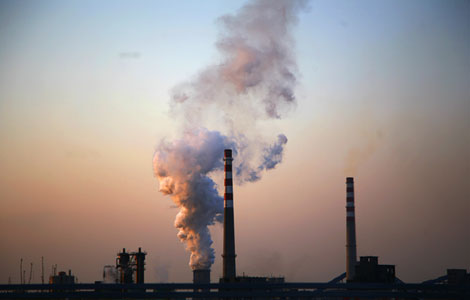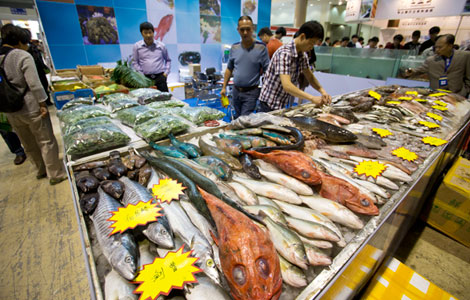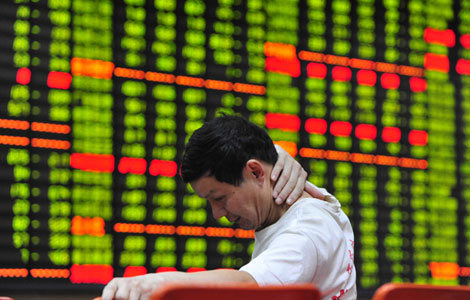
BEIJING -- Lin Yuanzhong has killed more than 40,000 ducklings in the past 10 days as there is no sign anyone will patronize his duck breeding farm in Zini Town, Longhai city in east China's Fujian province.
"If this continues for another 20 days, all the feed manufacturers, breeding farms and poultry raisers will be bankrupt," said Lin, who has been engaged in the industry for decades.
Even though the fast spread of H7N9 avian influenza has so far only hit Shanghai, Beijing and the provinces of Jiangsu, Zhejiang, Anhui and Henan, the ensuing fear has reached nationwide.
The outbreak since earlier this month has given China's poultry industry its hardest hit in a decade, with drastic declines in both poultry prices and consumption.
Xiao Zhiyuan, director of the poultry association of south China's Guangdong Province, labeled the current crisis "the worst in history."
The SARS outbreak in 2003, H5N1 in 2005 and H1N1 in 2009 inflicted at most a daily loss of 5 million yuan ($801,077) per company, but Guangdong Wen's Food Group Co Ltd, one of the largest poultry raisers in China, has suffered a loss of 20 million yuan in one day this time, according to Xiao.
"We lost up to 100 million yuan from April 1 to April 14 and the loss is expected to hit 150 million yuan this month," said Liang Zhiyong, general manager of Wen's Food Group Co Ltd's branch in Zhejiang Province.
"We have been trying to get financing from various channels, but the gap is still huge," said Liang.
The area worst hit by the H7N9 crisis is east China, where the largest number of human cases of the virus have been recorded.
The wholesale price of live chicken was three to four yuan per kg on April 15, one-third of the price before the outbreak, according to the Jiangsu Provincial Commission of Rural Affairs.
The wholesale price of eggs was 6.5 yuan per kg, down 20 percent compared with that of late March.
Four cities in Jiangsu, including the provincial capital of Nanjing, have shut down live poultry trading markets, stagnating sales of poultry.
In Xuzhou City alone, there are more than 300,000 live poultry to be sold every day.
Jiangsu Lihua Animal Husbandry Co Ltd, which sold 160 million broilers in 2012 and reaped 3 billion yuan in revenue, has killed more than 2.73 million growing broilers since the H7N9 outbreak as raising them will be cost-prohibitive, according to the commission.
As a whole, China's poultry industry suffered losses amounting to 10 billion yuan in the week after the first case of H7N9 was confirmed, according to the China Animal Agriculture Association.
The real impact of the disease will be far more than that as many consumers have been reluctant to eat poultry and some restaurants have stopped offering poultry dishes. The number of tourists visiting the affected provinces is also likely to decline.
To date, a total of 102 H7N9 cases have been reported in China, including 20 that have ended in death.
Government support crucial
Poultry breeding has been a major sideline and income source for Chinese farmers for centuries. The sluggish demand for these products has led large poultry enterprises to face the risk of capital chain rupture and the much smaller individual raisers to struggle to make ends meet.
"If the market does not recover within a month, the 400,000 ducklings in Longhai City will have to be killed," said Lin Shundong, director of the Longhai Duck Breeding Association.
Lin called for the government to immediately start purchasing poultry products from the non-affected provinces at the price they commanded pre-H7N9, a move that would not only boost market confidence at present, but also stabilize the market in case of a supply shortage when demand revives.
The government should also encourage poultry processing enterprises to purchase, slaughter the poultry, freeze the meat and sell it when conditions recover, Lin urged.
For poultry breeding companies and farmers in the affected areas, the government should subsidize their business, suggested Li Guoxiang, a researcher with the rural development institute under the Chinese Academy of Social Sciences.
"China should set up a systematic rescue mechanism," Li said. "Subsidies and rural insurance could be integrated to tackle the crisis."
So far, the governments of Shanghai and Zhejiang have released policies to support the poultry industry.
Under Shanghai's subsidy standard announced on April 10, poultry farms can get 15 yuan ($2.4) for each bird they have kept in stock between April 1 and 30. Individual farmers can get 3 yuan for egg-laying hens.
The Shanghai municipal government is also purchasing chickens from farmers at a set price to help them offset losses, and paying back poultry merchants for slaughtering their stocks with no less than 50 percent of the birds' market prices.
The Zhejiang provincial government issued a similar policy on April 16, giving subsidies to affected farmers, breeding farms and processing firms.
The government should also be highly alert to the risks behind massive culling of poultry, said Xiao Zhiyuan in Guangdong, advising that it make efforts to guarantee the safe disposal of culled poultry in special disposal pools to prevent any contagion.
To avoid a retaliatory price rebound in the future, the government should also give technological guidance to poultry raisers to protect their production capabilities, added Li Guoxiang.
 HK's new cruise terminal receives luxury liner
HK's new cruise terminal receives luxury liner
 Future points to carbon trading
Future points to carbon trading
 Seafood businesses flounder amid spending cut
Seafood businesses flounder amid spending cut
 Equities slump amid slow-growth estimates
Equities slump amid slow-growth estimates
 Auto show opens with much fanfare in Xi'an
Auto show opens with much fanfare in Xi'an
 Sunnylands summit fuels Chinese tourism interest
Sunnylands summit fuels Chinese tourism interest
 'Palace on wheels' on sale for $3.13m in Dubai
'Palace on wheels' on sale for $3.13m in Dubai
 Fortune smiles on Chengdu as forum concludes
Fortune smiles on Chengdu as forum concludes